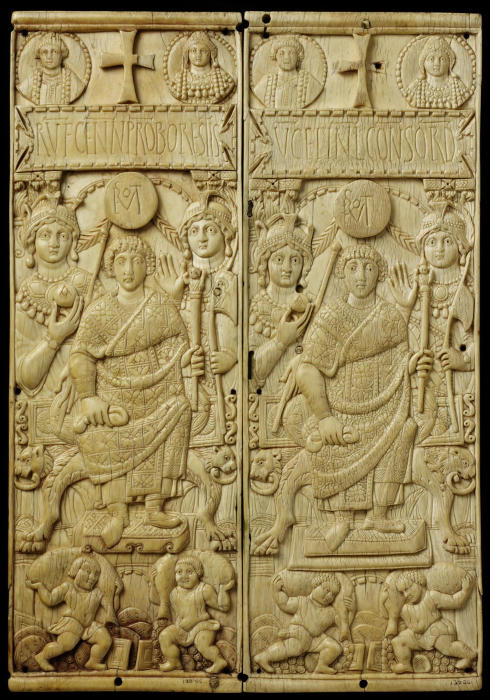Create an Amazon Wedding Registry

Try Amazon Audible Plus
Byzantine Ivory Diptych of Rufus Gennadius Probus Orestes, 530AD.
Victoria and Albert Museum 139-1866.

A larger image of this Byzantine Ivory Diptych of Rufus Gennadius Probus Orestes, 530AD. Victoria and Albert Museum 139-1866.
Object: Diptych
Place of origin: Rome (made)
Date: 530 (made)
Artist/Maker: Unknown
Materials and Techniques: Carved ivory
Marks and inscriptions: 'RVF(II) GENN(ADII) PROB(I) ORESTIS / V(IRI) C(LARISSIMI) INL(USTRIS) CONS(UL) ORD(INARIUS)' above the consul's head, on labels
Dimensions: Height: 34 cm, Width: 11.6 cm, Depth: 0.8 cm, Weight: 1.52 kg
Physical description: Consular Diptych of Rufius Gennadius Probus Orestes, one of the Western consuls in 530. The consul is represented on both leaves seated on a curule seat, holding in one hand the mappa circensis (with which he gave the signal for the games to begin), in the other a sceptre. A female figure, a personification of Constantinople with a disk and staff flanks the consul to his right; to his left stands a female personification of Rome holding the fasces. Clipeate portraits of Amalasuntha and her son Athalaric whom the consul served are above the inscription, flanking the cross. Below the consul two children empty sacks of money. At the top of each leaf are busts of an Emperor and Empress.
Object history note
From the Webb collection. Formerly in the the Museum Septalianum and in the Trivulzio collection in Milan, then in the Soltykoff collection until 1861 (sale 1861, No. 381).
Historical context note
Consular diptychs are formed by two panels hinged together. The outside bears carved decorations while the wax field on the inside was for inscribed messages. These were sent by newly appointed consuls to friends and members of the senate to announce their accession to the year-long position.
Despite the problem with the dating of the diptych, it visually conveys perfectly the two strands of argument: Faith and Power. The two figures of the consul stand for the old order in Rome and Constantinople with its power while the cross above him and the portraits of Amalasuntha, daughter of Theodorich and her son Athalaric represent the Ostrogothic regents of the Western empire and their faith.
Volbach assigns the diptych to Ravenna, pointing to the busts of Amalasuntha and Athalaric and stating that Orestes was resident in Ravenna. Also, the diptych copies that of Clementinus (513) from Constantinople (now in Liverpool). Nancy Netzer suggests that the present diptych was made in Constantinople at the time of Clementinus and that it was re-cut in certain areas in about 530.
Museum number: 139-1866
Victoria and Albert Museum
Consular Diptych of Rufius Gennadius Probus Orestes, one of the Western consuls in 530. The consul is represented on both leaves seated on a curule seat, holding in one hand the mappa circensis (with which he gave the signal for the games to begin), in the other a sceptre. A female figure, a personification of Constantinople with a disk and staff flanks the consul to his right; to his left stands a female personification of Rome holding the fasces. Clipeate portraits of Amalasuntha and her son Athalaric whom the consul served are above the inscription, flanking the cross. Below, in the lower part of the panel, two barefooted youths pour out sacks of coins, with ingots and silver laurel leaves.
A Roman aristocrat. He was appointed consul for the year 530. On 17 December 546 Orestes was in Rome when the Ostrogothic King Totila captured the city. Orestes, Anicius Olybrius and Anicius Maximus consuls, and other patricii sought refuge in Old St. Peter's Basilica. He afterwards joined a group of refugees who followed the Byzantine army as far as Portus. The following year, when some Byzantine soldiers were patrolling in Campania and encountered captured senators, who were freed and afterward sent to Sicily, he was left behind due to a lack of horses. Orestes was still a prisoner of the Visigoths when Narses conquered Rome in 552; the senators were preparing to return to Rome, but, enraged by the death of Totila, the Goths who guarded them killed them all.
The monogram at the top represents the Symmachi, a prominent Roman family who petitioned Emperor Gratian (AD 375-383) for the freedom of pagan worship.
Other Illustrations of Byzantine Costume & Soldiers
6th Century Illustrations of Costume & Soldiers


